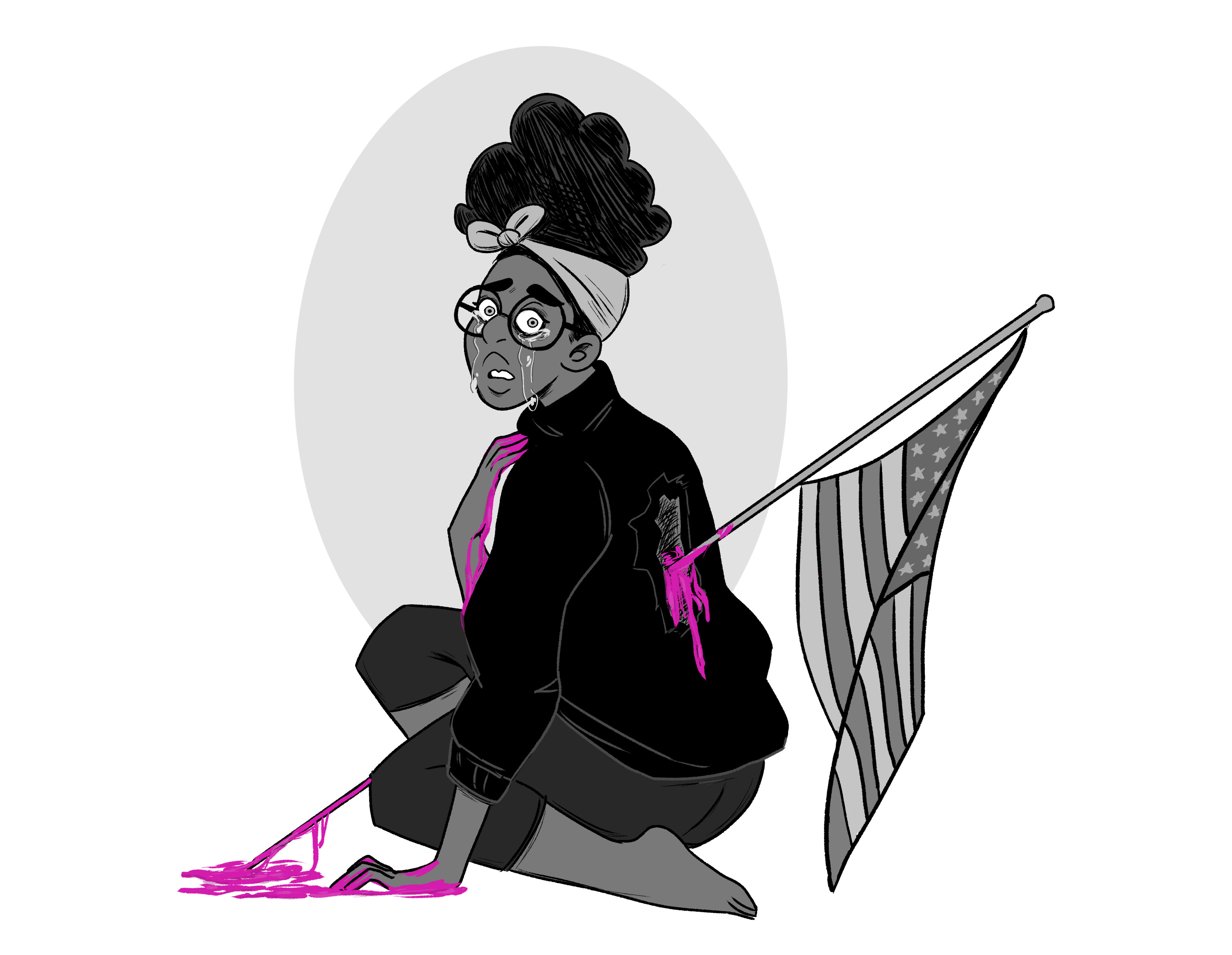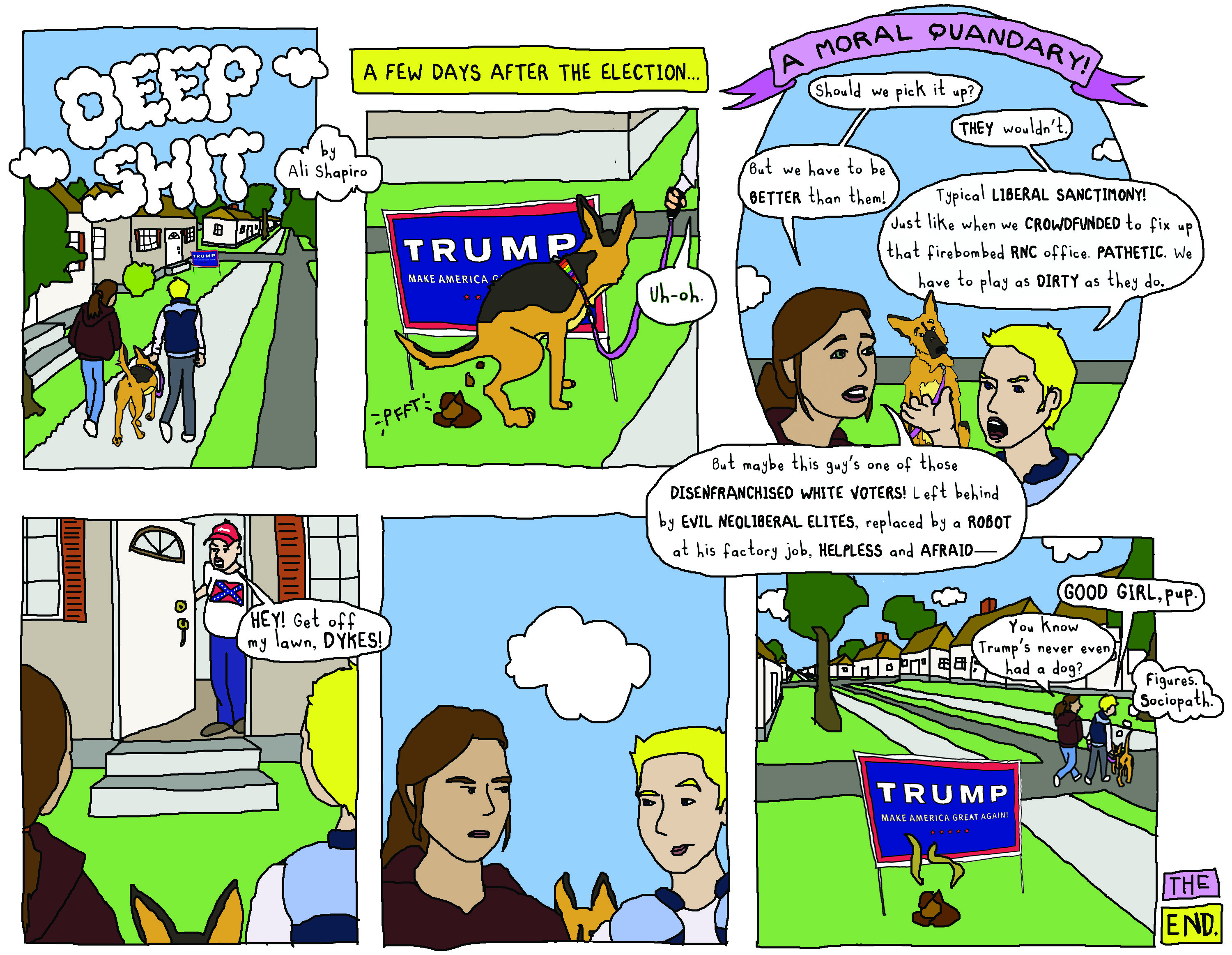The words A Woman’s Place is in the Revolution cut across a sea of faces representing American women on the front page of RESIST! The paper, a special issue of Gabe Fowler’s quarterly tabloid comics anthology Smoke Signal, includes pieces by over 100 artists of varying ages, genders, races, and socioeconomic backgrounds, but is mostly the work of women. (The cover illustration is by The New Yorker cover artist Gayle Kabaker.) A whopping 58,000 copies have been printed and are being distributed across the country.
“It started from the paralysis right after the election,” Françoise Mouly told me over a Google Hangout with her co-editor and daughter Nadja Spiegelman. Mouly is the art director at The New Yorker and publisher at Toon Books. She and Fowler knew one another through the world of comics—Fowler organizes a yearly comics festival in Brooklyn and is the owner of Desert Island, a comics store. Fowler asked Mouly to guest edit this special issue “because he felt it should be women’s voices,” she said. The project seemed like a tangible and quickly actionable endeavor, and Mouly agreed to do it, recruiting Spiegelman to help with organizing submissions and building a website. “I loved the idea of seeing what the world had to say,” Mouly explained.
Videos by VICE
The issue includes work donated by the likes of Alison Bechdel, Lynda Barry, Roz Chast and Liana Finck, but as Spiegelman (whose father is Maus cartoonist Art Spiegelman) told me, “80 to 85 percent are things that came through the open call.” She and Mouly changed the call for submissions on the RESIST! website several times in order to refine and explain what they were looking for: comics of varying sizes, with images by women being “privileged,” as Mouly put it, over men’s submissions. However, the issue dedicates the final pages to men’s work, as well as a page featuring gender-nonconforming artists. Mouly and Spiegelman ended up with over a thousand submissions, all of which will appear on the site over time.
The editorial process, Spiegelman said, was unique for her and Mouly—they felt they were midwives more than editors. “Rather than saying, ‘Do we like this, do we not like this, do we agree with this, do we not agree with this?’ we were trying to add in as many voices and styles as possible so that there’s the full range and diversity of the collective voice.”
“There’s a substantial portion of professional artists [in the issue],” Mouly added, “but there are also people who can’t draw to save their lives, doctors and dentists and auto mechanics that have not until now used comics or drawing. For an art director, this is so exciting because it is such a real visualization of the energy that drawing can channel when you let it happen.”
The project has created a grassroots network of distributors (you can become one here), volunteers in various cities around the US who will be getting massive amounts of copies and will work with their local connections to get the paper in bookstores and other spaces. “I think it’s a way of beginning to define what we’re for,” Spiegelman said. “We’re for unity, diversity, creativity. By making this manifest, by printing so many copies and papering the streets with it—it’s being the change you want to see in the world.”

Joan Reilly
One of the volunteers is Joan Reilly, a 44-year-old cartoonist and illustrator who contributed to RESIST!. She lives in Kutztown, Pennsylvania, and she and her husband have been “getting involved with the local literate, artistic, future-thinking community.” Distribution for her “may end up being a door-to-door, town-to-town road-trip type of thing, but I am passionate about getting it into people’s hands, so I’ll make it happen one way or another.”

Jazmine Boatman
Other contributors I spoke to were similarly determined. Jazmine Boatman, a 22-year-old college student and freelance illustrator, said that she felt betrayed after the election: “Not only had I just watched our nation elect an awful, vile, childish, racist, sexist, homophobic, xenophobic, inexperienced, etc. man as our next president but I also had to cope with the fact that quite a few people close to me had voted for him. There’s probably going to be a lot of pain and struggling for the next couple of years and that is exactly why artists are needed now more than ever. Artists in all forms of media need to be even bolder in their statements and more assertive and insistent on making sure their voices are heard. People are going to want to know that they are not alone in their fears and concerns and those who are not afraid need to know why a lot of people are. Publications like RESIST! are setting an example by giving artists like me a platform and a chance to share our feelings with people on a larger scale.”

Quinn Nelson
Quinn Nelson, a 13-year-old contributor, told me that “RESIST! will spread awareness of the fact that people have very real and raw emotions about the election and everything it stands for.” She added, with wonderfully prescient understanding of feminist history, “Typically, feminist movements are very white. Hopefully, because of the racist ideals Trump stands for, more ethnically diverse women and men alike will participate this time around.”

Ali Shapiro
Ali Shapiro, a 33-year-old cartoonist and lecturer at the University of Michigan, was more skeptical about the project, but still eager: “I tend to vacillate between ‘Everything matters and art must save the world!’ and ‘Oh well, nothing matters, may as well make art.’” But she also sees a possibility in this medium of communication: “We have a fake news problem, right? Which tells me (among other things) that we need to find new ways to communicate important information and ideas. Maybe comics can help! Maybe visual language can produce empathy in ways written words can’t. Maybe comics journalists (like Joe Sacco and Josh Neufeld, e.g.) can render sources (and their relative trustworthiness) visible and accessible in ways a hyperlink in the middle of a dense news article can’t.”
Gabe Fowler’s outlook was also less hopeful. “I’ve never been more skeptical in my whole life as I am right now,” he said. “The election itself was proof that communication is impossible, so I don’t really expect to change anyone’s mind with this paper and I questioned that all the way through—why are we even doing this? Well, there is a cathartic benefit to artists participating in an avenue for expression to just get rid of some of these negative feelings. All I can do is attempt to create a platform to expunge some of these bad vibes.” He went on, “I think it is the duty of anyone who is upset to make it as visible as possible all the time. There’s no other way.”
Both Fowler and Spiegelman are going to Washington, DC, for inauguration and the Women’s March on January 21. “To me, inauguration day is the target,” Fowler told me. “The people who need to see the content of this newspaper are the people who will be at inauguration, the Trump supporters. Getting it to the people who are marching is important, and it’s a gesture of solidarity, but it is also preaching to the converted.” How distribution will work at the inauguration is still a mystery, as a van full of papers will need to be inside the area that is closed off to nonresident parking on days before and after January 20 so that Fowler, Spiegelman, and volunteers will be able to unload and hand out copies without needing to go through security checkpoints.
Despite the difficulties in putting together the issue and the still-open questions regarding the project’s future—if it has one, which is unclear, though the website will continue to be updated often—Mouly and Spiegelman were invigorated by the endeavor. “What we experienced personally,” Mouly said, as Spiegelman nodded emphatically, “was a reconnection with optimism, and a belief that the future will be something we can inhabit because we’ll be making it and we’ll be a part of it. This clearly demonstrates the power of collective arm-holding. There is a collective will that is not xenophobic, racist, sexist, but is very democratic and knows how to express itself.”
Follow Ilana Masad on Twitter.
More
From VICE
-

Collage by VICE -

Sara Benabdallah -

Photo by Ollie Valentine via The Table Hay on Instagram. -

Collage by Vice
